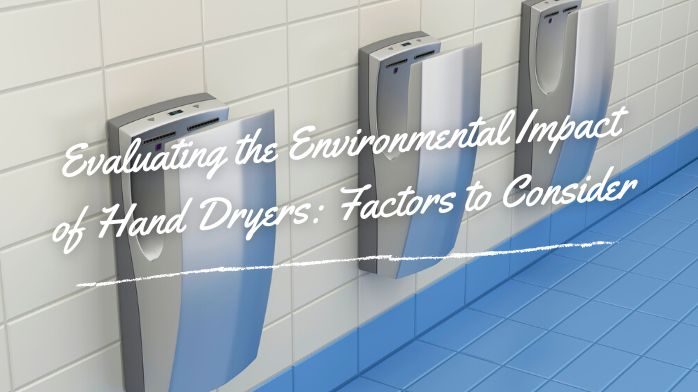There are different ways to consider environmental friendliness regarding hand dryers. One aspect to consider is the energy efficiency of the device. Hand dryers can be more energy efficient than paper towels, mainly if they use high-speed, low-energy technology. However, the environmental impact of a hand dryer also depends on how it is powered. If renewable energy sources power it, it may be more environmentally friendly than a hand dryer powered by nonrenewable energy sources.
It’s also worth considering the environmental impact of the manufacturing and disposal of hand dryers. Hand dryers are made from various materials, some of which may be more environmentally friendly than others. Similarly, the disposal of hand dryers at the end of their lifespan can impact the environment. If a hand dryer is not disposed of properly, it can contribute to pollution and waste.
It isn’t easy to make a blanket statement about the environmental friendliness of hand dryers. It is essential to consider all factors that can impact their ecological impact, including energy efficiency, power source, and disposal.
Materials Used in Hand Dryers
Hand dryers can be made from various materials, including plastic, metal, and electronic components.
The body of a hand dryer is often made from plastic or metal. Plastic hand dryers are generally lighter and may be less expensive to manufacture, but they may not be as durable as metal hand dryers. Metal hand dryers, such as those made from stainless steel, are generally more durable and may be more resistant to damage, but they may be more expensive to manufacture.
Hand dryers also contain various electronic components, such as motors, heating elements, and sensors. These components are typically made from metal and may be housed in a metal or plastic casing.
The manufacturing process for hand dryers can have an environmental impact, depending on the materials used and the manufacturing practices employed. When evaluating their overall environmental friendliness, it is essential to consider the ecological effects of the materials used in hand dryers.

Recyclability of Hand Dryers
The recyclability of hand dryers depends on the materials used to make them and the availability of recycling programs in a particular location.
Hand dryers are made from various materials, including plastic, metal, and electronic components. Some of these materials, such as metal, are more easily recycled than others, such as certain types of plastic. The recyclability of a hand dryer may also depend on the specific model and design.
Recycling many of the materials used in hand dryers is possible. Metal components, such as the motor and heating element, can often be recycled through metal recycling programs. Plastic components can also be recycled, although the specific type of plastic used may determine its recyclability. Electronic components may contain hazardous materials and should be disposed of properly.
The availability of recycling programs for hand dryers can vary by location. Some areas may have programs for recycling hand dryers, while others may not. It is always important to check with local recycling programs to determine the proper disposal methods for hand dryers.
Overall, the recyclability of hand dryers depends on the materials used to make them and the availability of recycling programs in a particular location.
Disposal of Hand Dryers
The disposal of hand dryers at the end of their lifespan can have an environmental impact, so it is important to recycle or properly dispose of them.
One option for disposing of hand dryers is to recycle them. Many materials used in hand dryers, such as metal and plastic, can be recycled. The recyclability of a hand dryer may depend on the specific model and its design and the availability of recycling programs in a particular location. It is always important to check with local recycling programs to determine the proper disposal methods for hand dryers.
Another option for disposing of hand dryers is to donate or sell them for reuse. Hand dryers still in good working condition may be usable by others and can be donated or sold to be used again. This can be more environmentally friendly than simply disposing of a hand dryer.
If a hand dryer is no longer usable and cannot be recycled or donated, it should be disposed of properly. Electronic components of hand dryers may contain hazardous materials, such as mercury, and should be disposed of according to local regulations. Following proper disposal, guidelines are essential to minimize hand dryers’ environmental impact.
Environmental Impact of Paper Towels
There are several environmental impacts associated with the use of paper towels.
One of the main environmental impacts of paper towels is their impact on trees and natural habitats. Paper towels are made from wood pulp, which comes from trees. The production of paper towels requires using trees, which can contribute to deforestation and habitat destruction. In addition, the transportation of paper towels can contribute to air pollution.
Another environmental impact of paper towels is the water and energy used in their production. Paper paper towels require a lot of water and energy, which can negatively impact natural resources.
The disposal of paper towels also has an environmental impact. Many paper towels are not recyclable and end up in landfills, which can take years to decompose. This can contribute to landfill waste and pollution.
Overall, the environmental impact of paper towels depends on various factors, including the methods used to produce them, the resources used in their production, and their disposal. It is essential to consider these factors when evaluating the environmental impact of paper towels.
Comparison of Hand Dryers and Paper Towels
Regarding their environmental impact, there are several factors to consider when comparing hand dryers to paper towels.
One factor is the energy efficiency of the two options. Some studies have found that hand dryers can be more energy efficient than paper towels, especially if they use high-speed, low-energy technology. However, the energy efficiency of hand dryers can vary depending on the specific model and how it is used. In contrast, paper towels do not require energy since they are thrown away after use.
Another factor to consider is the environmental impact of the manufacturing and disposal of hand dryers and paper towels. The production of paper towels requires the use of trees and water, and the disposal of paper towels can contribute to landfill waste. In contrast, hand dryers are made from various materials, some of which may have a lower environmental impact than the materials used to make paper towels.
However, the disposal of hand dryers at the end of their lifespan can also have an environmental impact, so it is important to recycle or properly dispose of them. It’s also worth considering the water usage of hand dryers compared to paper towels. Some hand dryers use a small amount of water to help remove excess moisture from the hands, while others do not use any water at all. In contrast, paper towels do not use any water.
Overall, the environmental impact of hand dryers and paper towels depends on various factors, including energy efficiency, manufacturing and disposal practices, and water usage. It is essential to consider all of these factors to decide which option is more environmentally friendly.

